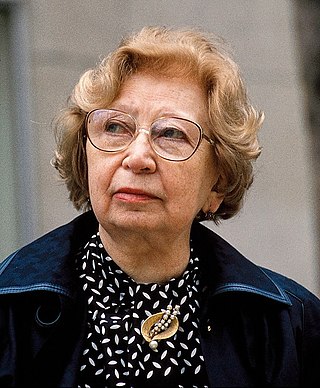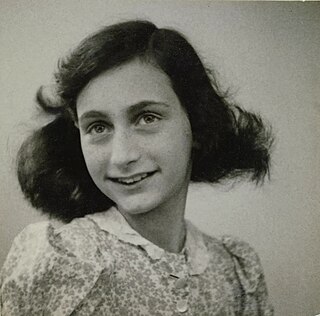
Otto Heinrich Frank was the father of Anne Frank. He edited and published the first edition of her diary in 1947 and advised on its later theatrical and cinematic adaptations. In the 1950s and the 1960s, he established European charities in his daughter's name and founded the trust which preserved his family's wartime hiding place, the Anne Frank House, in Amsterdam.

Hermine "Miep" Gies was one of the Dutch citizens who hid Anne Frank, her family and four other Dutch Jews from the Nazis in an annex above Otto Frank's business premises during World War II. She was Austrian by birth, but in 1920, at the age of eleven, she was taken in as a foster child by a Dutch family in Leiden to whom she became very attached. Although she was only supposed to stay for six months, this stay was extended to one year because of frail health, after which Gies chose to remain with them, living the rest of her life in the Netherlands.

Annelies Marie "Anne" Frank was a German-born Jewish girl who kept a diary documenting her life in hiding amid Nazi persecution during the German occupation of the Netherlands. A celebrated diarist, Frank described everyday life from her family's hiding place in an Amsterdam attic. She gained fame posthumously and became one of the most-discussed Jewish victims of the Holocaust with the 1947 publication of The Diary of a Young Girl, which documents her life in hiding from 1942 to 1944. It is one of the world's best-known books and has been the basis for several plays and films.

Anne Frank Remembered is a 1995 British documentary film produced and directed by Jon Blair about the life and posthumously published diary of the German-Jewish diarist Anne Frank, who spent most of her life in the Netherlands. The film was produced in association with the Anne Frank House, Disney Channel, and the BBC, and features narration by Kenneth Branagh and extracts from Frank's diary read by Glenn Close. It originally aired on television in April 1995 before it was screened theatrically by Sony Pictures Classics in February 1996.

The Diary of a Young Girl, commonly referred to as The Diary of Anne Frank, is a book of the writings from the Dutch-language diary kept by Anne Frank while she was in hiding for two years with her family during the Nazi occupation of the Netherlands. The family was apprehended in 1944, and Anne Frank died of typhus in the Bergen-Belsen concentration camp in 1945. Anne's diaries were retrieved by Miep Gies and Bep Voskuijl. Miep gave them to Anne's father, Otto Frank, the family's only survivor, just after the Second World War was over.

Karl Josef Silberbauer was an Austrian police officer, Schutzstaffel (SS) member, and undercover investigator for the West German Bundesnachrichtendienst. He was stationed in Nazi-occupied Amsterdam during World War II, where he was promoted to the rank of Hauptscharführer. In 1963, Silberbauer, by then an inspector in the Vienna police, was exposed as the commander of the 1944 Gestapo raid on the Anne Frank House Secret Annex and the arrests of Anne Frank, her fellow fugitives, and two of their protectors, Victor Kugler and Johannes Kleiman.

Margot Betti Frank was the elder daughter of Otto Frank and Edith Frank and the elder sister of Anne Frank. Margot's deportation order from the Gestapo hastened the Frank family into hiding. According to the diary of her younger sister, Anne, Margot kept a diary of her own, but no trace of it has ever been found. She died in Bergen-Belsen concentration camp from a typhus outbreak.

Friedrich "Fritz" Pfeffer was a German dentist and Jewish refugee who hid with Anne Frank and her family and the Van Pels family during the Nazi occupation of the Netherlands. He perished in the Neuengamme concentration camp in Northern Germany. Pfeffer was given the pseudonym Albert Dussel in Frank's diary, and remains known as such in many editions and adaptations of the publication.

Jan Augustus Gies was a member of the Dutch Resistance who, with his wife, Miep, helped hide Anne Frank, her sister Margot, their parents Otto and Edith, the van Pels family, and Fritz Pfeffer from Nazi persecution during the occupation of the Netherlands by aiding them as they resided in the Secret Annex.

Victor Kugler was one of the people who helped hide Anne Frank and her family and friends during the Nazi occupation of the Netherlands. In Anne Frank's posthumously published diary, Het Achterhuis, known in English as The Diary of a Young Girl, he was referred to under the pseudonym Mr. Kraler.

Johannes Kleiman was one of the Dutch residents who helped hide Anne Frank and her family during the Nazi occupation of the Netherlands. In the published version of Frank's diary, Het Achterhuis, known in English as The Diary of a Young Girl, he is given the pseudonym Mr. Koophuis. In some later publications of the diary, the pseudonym was removed, and Kleiman was referred to by his real name.

Elisabeth "Bep" Voskuijl was a resident of Amsterdam who helped conceal Anne Frank and her family from Nazi persecution during the occupation of the Netherlands. In the early versions of Het Achterhuis, known in English as The Diary of a Young Girl, she was given the pseudonym "Elli Vossen".

Edith Frank was the mother of Holocaust diarist Anne Frank and her older sister Margot. After the family were discovered in hiding in Amsterdam during the German occupation, she was transported to Auschwitz-Birkenau concentration camp.

The Anne Frank House is a writer's house and biographical museum dedicated to Jewish wartime diarist Anne Frank. The building is located on a canal called the Prinsengracht, close to the Westerkerk, in central Amsterdam in the Netherlands.
The Diary of Anne Frank is a BBC adaptation, in association with France 2, of The Diary of a Young Girl originally written by Anne Frank from 1942 to 1944 and adapted for television by Deborah Moggach.
Johannes Hendrik Voskuijl was one of the people who helped to hide Anne Frank and the other people of the Secret Annex in Amsterdam. He was the father of helper Bep Voskuijl, who is known as "Elli Vossen" in the earliest editions of Het Achterhuis, known in English as The Diary of Anne Frank. Voskuijl himself is named "Mr. Vossen." Voskuijl built the famous bookcase that covered the hiding place.
The Diary of Anne Frank is a 1967 TV film based on the posthumously published 1947 book The Diary of a Young Girl by Anne Frank. The teleplay was directed by Alex Segal and it was adapted by James Lee from the 1955 play of the same name by Albert Hackett and Frances Goodrich. The film starred Max von Sydow, Diana Davila, Peter Beiger, Theodore Bikel and Lilli Palmer.

Das Tagebuch der Anne Frank is a 2016 German drama film directed by German filmmaker Hans Steinbichler and written by Fred Breinersdorfer. It stars Lea van Acken as the titular character, Martina Gedeck, Ulrich Noethen, and Stella Kunkat. The film is based on Anne Frank's famous diary and tells the story of Anne Frank, the Jewish girl who went into hiding with her family in Amsterdam and became a victim of the Holocaust.
ANNE is a 2014 play dramatising the story of Jewish diarist Anne Frank's period in hiding in the Secret Annex in Amsterdam during the Second World War. The play was the first major new adaptation of Frank's diary since the 1955 play, and was both authorised and initiated by the Anne Frank Foundation in Basel, the organisation set up by Frank's father Otto Frank to preserve his daughter's legacy and work. As such, Anne was the first adaptation allowed to quote literal passages from the diary. After a near two-year run in the Netherlands, the play closed in 2016, and had production runs in Germany and Israel. The play also formed the basis for the first German film adaptation of the diary.















